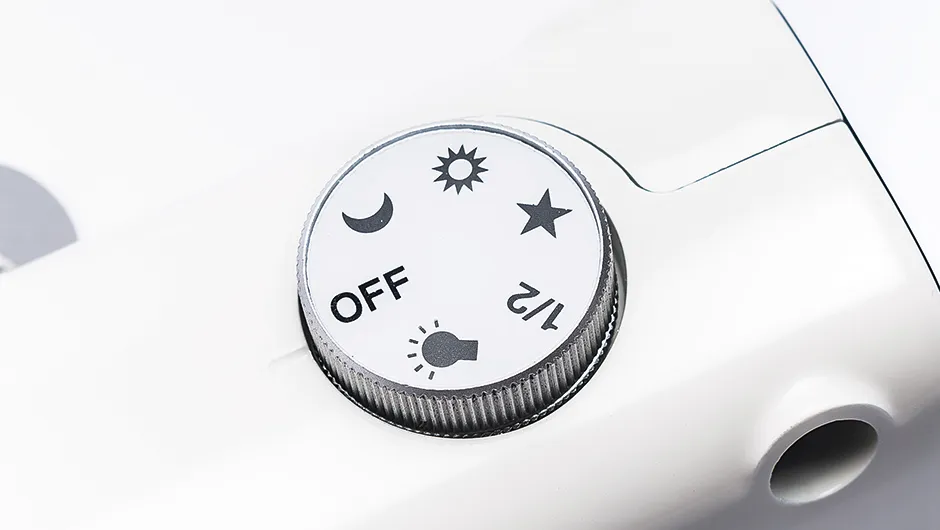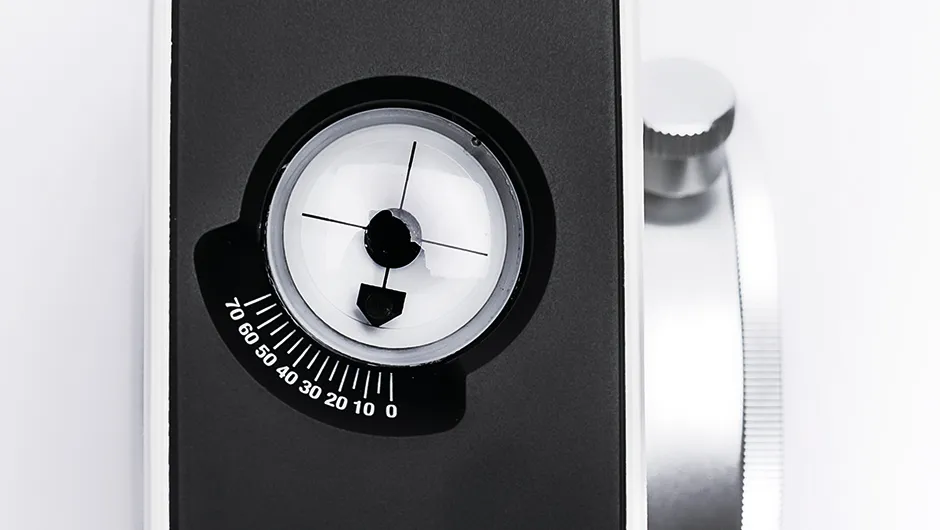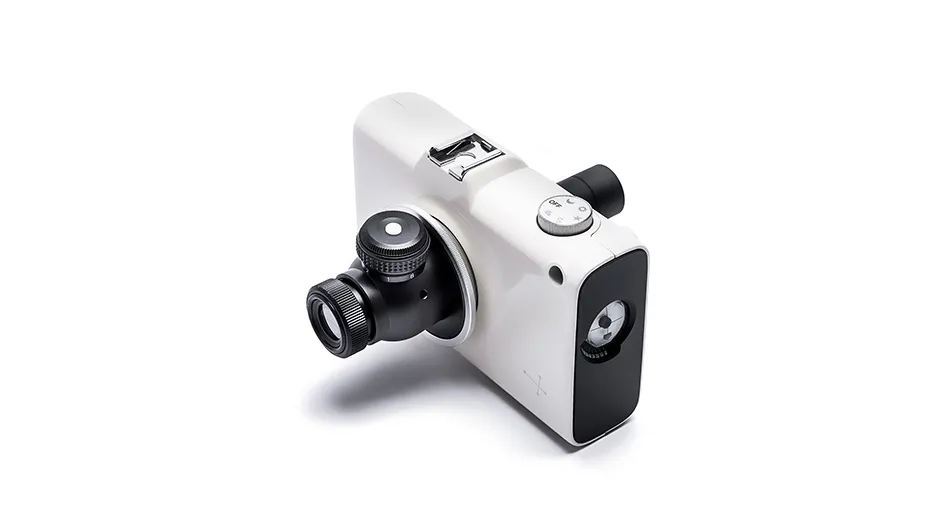The Polarie Star Tracker looks nothing like a conventional equatorial mount.Visually, it has more in common with a compact camera.Yet this appearance is deceptive – what you are looking at is a diminutive but substantially constructed equatorial tracking platform.
Ultra-portable imaging mounts are very popular at the moment, and the understated design of this one oozes quality.
This latest version has some useful upgrades that build on the success of its predecessor.
A comprehensive set of printed manuals is included in the package and a small compass for locating the north or south pole is conveniently stowed in the polarscope cover plate on the rear of the mount.
Power is supplied by either two internal AA batteries (giving about two hours of tracking) or externally through a mini-B USB cable (not supplied).
Straight out of the box, the payload capacity is a modest 2.5kg, which is more than adequate for a DSLR camera and a standard lens.
However, the new upgrade kit increases this to a generous 6.5kg.
In common with other ultra-portable mounts of this type, the Polarie only moves in right ascension (RA); there is no declination (dec.) axis as such.
You aim your camera lens or telescope manually by adjusting an optional ball and socket head and, once the object is acquired, you start the Polarie and RA tracking commences at the selected rate.
The ball and socket head fits onto the drive capstan via a removable platform with a retracting tripod bush bolt or – if the upgrade kit is being used – onto the end of a sliding dovetail bar.
We found that a great way of aiming our camera lens accurately was to use a small red-dot finder of our own, mounted on top of our DSLR camera’s hot shoe bracket.

Speeds and modes
There are four tracking speeds – lunar, solar, sidereal and half sidereal, the latter allowing a reasonable balance between a small amount of star trailing against a less blurred foreground when capturing starscapes.
The various tracking speeds, the off position and the ‘illumination’ mode are selected using the rotary switch on the top of the mount.
In illumination mode, the built-in latitude scale glows red and the rotary switch glows either red for northern hemisphere or green for southern hemisphere.
A miniature switch hidden behind the battery box cover is used to select hemisphere drive direction.
We mounted the Polarie, via the supplied adjustable wedge, onto our own Manfrotto #132 tripod using a standard 3/8-inch tripod bush; a 1/4-inch bush and a removal tool are also included in the kit.
Fast and simple polar alignment is carried out using a sighting hole through the body of the mount, but much more accurate alignment can be achieved by using the supplied polarscope.
Using the standard RA axis platform, the polarscope must be removed before the camera is attached, but the upgrade kit allows the polarscope to remain in place throughout an imaging session so you can easily check that alignment is being maintained.
The key to accurate tracking with an unguided RA only mount is to ensure a good polar alignment is achieved.To that end, we found the included polarscope gave us a more than adequate alignment.
There is also an excellent free smartphone app (Vixen PF-L Assist, available for iOS and Android) to make polar alignment really simple.
We tested the mount using a DSLR and CCD camera, 200mm telephoto lens and the upgrade kit, capturing five-minute exposures of a region of the sky just above the celestial equator centred first on the mag.
4.7 binary star Pi Virginis and then NGC 7000, the North America Nebula.
We were very impressed with the tracking, which showed no visible signs of star trailing.
The Polarie is suitable for both beginners to astrophotography, where its simple operation is a real plus point, and for more advanced imagers looking for a portable imaging solution.

A very worthy upgrade
The upgrade kit for the Polarie Star Tracker increases the payload capacity from 2.5kg to 6.5kg, making it suitable for longer focal length lenses and small telescopes.
The upgrade kit includes a dovetail mounting block, sliding dovetail bar, counterweight bar, 0.95kg counterweight, adjustable equatorial wedge and an updated polarscope.
The heavy-duty dovetail mounting block fits onto the driven mounting capstan in place of the original flat platform.
The polarscope can be left in place as the block has a sight hole through which you can view the sky and the sliding dovetail bar has a long slot down its centre for the same reason.
Balance is achieved by releasing a clutch and offsetting the sliding dovetail bar and counterweight to suit, although we found the mounting block was a little stiff even with the clutch disengaged.
Instead of relying on the adjustable head of a tripod to set the correct elevation and azimuth of the mount, the adjustable wedge makes this a simple task.

Multi-function switch
Neatly positioned on the top of the Polarie is a small rotating knob that turns the unit on and allows you to select a tracking rate or the illumination mode. There are four tracking rates: sidereal, half sidereal, solar and lunar. The illumination mode adds a glow to the dial and the altitude scale.
RA Axis platform
There is an elegantly machined mounting capstan comprising a motor driven base and a flat platform with an embedded 1/4”-20 bolt for the camera on the skyward-facing front. A lightweight camera and lens on a ball and socket head can be installed directly or the platform can be replaced with the counterbalanced arm.
Sighting hole
A small sighting hole is incorporated in the body of the Polarie to allow for a quick polar alignment suitable for short exposures with wide-field camera lenses. This is very easy to use after achieving an approximate latitude adjustment using the latitude scale. The sighting hole delivers approximately an 8.9° field of view.
Latitude scale
A small latitude scale, graduated from 0° to 70°, is built into the left side of the Polarie. It can be illuminated in red using the rotating switch. Although the scale is rather coarse (the graduations are in 5° increments) it is more than adequate for preparing for polar alignment through the sight hole or polarscope.
Polarscope
To increase the polar alignment accuracy for longer exposures and for use with longer focal length lenses, you’ll need to install the illuminated polarscope through the drive capstan. The polarscope can be used in conjunction with a smartphone app to achieve polar alignment.
Vital stats
- Price£1039.00
- Weight0.75kg
- SupplierOpticron
- Telephone01582 726522
- Websitewww.vixenoptics.co.uk
This review originally appeared in the August 2017 issue of BBC Sky at Night Magazine.
